Dual-Core Implantable Fiber Optic Cannulae
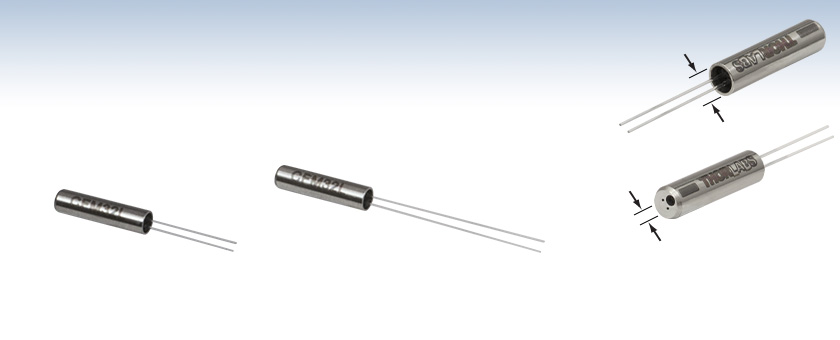
- Dual-Core Cannulae with 700 µm Core Spacing
- Two Ø200 µm Core Fibers with 0.39 NA
- Ø2.5 mm Stainless Steel Ferrule
- Custom Versions Available
CFM32L10
L = 10 mm
CFM32L20
L = 20 mm
Ø2.5 mm
Fiber Features a Precision Flat-Cleaved End
Ø2.5 mm Stainless Steel Ferrule Features an Alignment Pin Hole and 700 µm Core Spacing
700 µm

Please Wait
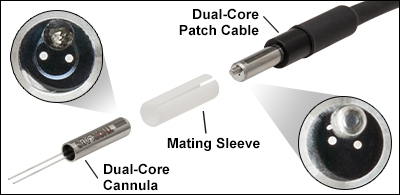
Click to Enlarge
Thorlabs' Implantable Dual-Core Fiber Optic Cannulae are Compatible with our ADAF1 Mating Sleeve and Dual-Core Optogenetics Patch Cables
| Key Specifications | |
|---|---|
| Ferrule Size | Ø2.5 mm x 10 mm |
| Ferrule Material | Stainless Steel |
| Mass | Approx. 0.18 g (0.0004 lbs) |
| Fiber Length | 10 or 20 mm |
| Fiber Length Tolerance | ±0.250 mma |
| Fiber Termination | Flat Cleave |
Features
- Dual-Core Fiber Optic Cannulae for Bilateral Stimulation or Silencing Optogenetics Applications
- Scorable Stainless Steel Ferrule for Better Adhesion to Skull
- Ø200 µm, 0.39 NA Fiber with 700 µm Core Spacing
- 10 or 20 mm Fiber Lengths
- Sold Individually; Volume Pricing is Available
(Contact optogenetics@thorlabs.com) - Contact Tech Support for Custom Cleave Length, Fiber Diameter, or Core Spacing
| Fiber Optic Cannula Selection Guide |
|---|
| Ø105 µm Core, 0.22 NA Fiber |
| Ø200 µm Core, 0.22 NA Fiber |
| Ø200 µm Core, 0.39 NA Fiber |
| Ø200 µm Core, 0.50 NA Fiber |
| Ø300 µm Core, 0.39 NA Fiber |
| Ø400 µm Core, 0.39 NA Fiber |
| Ø400 µm Core, 0.50 NA Fiber |
| Dual-Core Cannula |
| Cannulae with Diffuser Tip |
The dual-core cannulae sold on this page are specifically designed to be used with our dual-core fiber optic patch cables. Thorlabs' dual-core products allow high-intensity light from two different sources to be implanted within a specimen in close proximity (~1 mm), and are therefore ideal for applications such as bilateral stimulation or silencing.
These cannulae feature a Ø2.5 mm stainless steel ferrule with two Ø200 µm, 0.39 NA multimode fibers spaced 700 µm apart. Versions with a 10 mm or 20 mm fiber length are available from stock; for custom lengths, please contact Tech Support. Unlike a cannula with a single fiber, a dual-core cannula allows two fibers to be surgically implanted in a single procedure using stereotactic guidance. The stainless steel ferrule is easy to score for better adherence when implanted and fixed with glue.
For ease of use and alignment, the stainless steel ferrule is equipped with a Ø0.03" (Ø0.8 mm) guide hole which holds a matching mating pin in our dual-core patch cables using either the ADAF1 Mating Sleeve or ADAF2 Interconnect. As seen in the animation to the right, the mating pin and guide hole ensure precise alignment of the two fiber cores. The ferrule is engraved with an alignment mark that corresponds to a matching engraving on our dual-core fiber patch cables (see the image to the right). For more details on the usage of the dual-core patch cable and cannula, please see the Usage Tips tab above.
Each cannula includes a protective cap that shields the ferrule end from dust and other hazards when not in use. Additional caps, such as the CAPF Plastic Caps, are sold separately. If the ferrule or fiber ends become dirty from use, we offer a selection of inspection tools and fiber optic cleaning products.
Optogenetics Product Family for In Vivo Applications
The image below illustrates an example dual-core optogenetics system. Thorlabs offers a wide variety of products designed to support in vivo optogenetics applications. Please visit the OG Selection Guide tab above to see a full listing of available products for different applications.
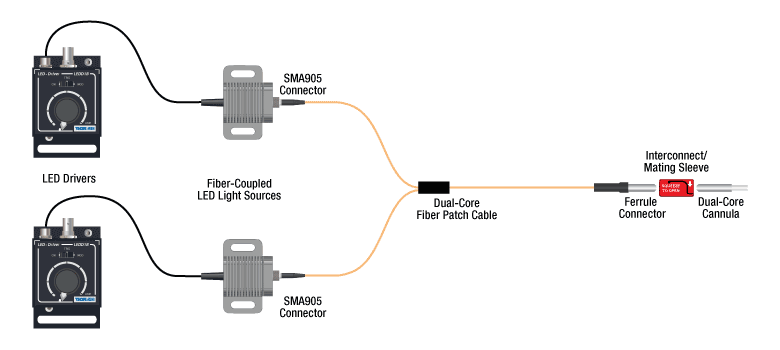
| Related Optogenetics Products | ||||
|---|---|---|---|---|
| Light Sources | Patch Cables (Ø200 µm Core, 0.39 NA) | Mating | Cannulae (Ø200 µm Core, 0.39 NA) | Accessories |
| Fiber-Coupled LEDs MM Laser, 473 nm |
Standard Rotary Joint Dual Core Bifurcated Y-Cables 1-to-7 Fiber Bundles |
Interconnects Mating Sleeves |
Standard Dual Core Diffuser Tip |
Implant Guides Cannula Holders |
This tab contains instructions for assembling and disassembling a dual-core fiber optic patch cable and cannula. The animation to the right illustrates the assembly process using a dual-core patch cable, ADAF1 lightweight mating sleeve, and dual-core cannula. The ADAF2 Quick-Release Interconnect, which provides lower-force connections than the ADAF1 mating sleeve, can be found here.
Step 1: Ensure that the patch cable ferrule tip is clean and free of dust; we recommend our canned compressed air. Then, insert the patch cable ferrule approximately halfway into the Ø2.5 mm mating sleeve (Item # ADAF1). The ferrule should fit tightly within the mating sleeve.
Step 2: Similarly ensure that the ferrule tip of the cannula is clean and free of dust. Then, insert the cannula ferrule into the mating sleeve from the other side. If the two ferrules are properly aligned, the engraved markings on each ferrule should be aligned; if not, rotate the cannula until the engravings align.
Step 3: Once aligned, gently press the two ferrules together until contact is achieved. Do not try to force the two ferrules together; if the alignment pin is misaligned, this may damage the ferrule.
For best results when disassembling, hold the patch cable near the jacket/ferrule interface and gently pull the ferrule from the ADAF1 mating sleeve.
| Posted Comments: | |
Tal Berkovits
(posted 2021-03-02 17:22:18.263) Hi,
I have visited your website looking for dual - hole Ferrule.
I need 2 holes, each hole diameter needs to be of 150 um, and the distance between the holes should be 425 um (from center to center)
Can you custom this?
thank's,
Tal Berkovits asundararaj
(posted 2021-03-02 10:06:56.0) Thank you for contacting Thorlabs. Custom items can be requested by using the "Request Quote" button above or by contacting your local Thorlabs Tech Support Team. We will reach out to you directly to discuss the possibility of offering this. |
| Quick Links | |||
|---|---|---|---|
| Single-Site Stimulation | |||
| One Light Source to One Cannula Implant | |||
| Multilateral Stimulation | |||
| One Light Source to Two Cannula Implants Using Rotary Joint Splitter | |||
| One or Two Light Sources to Two Cannula Implants | |||
| One Light Source to Seven Cannula Implants | |||
| Two Light Sources into One Dual-Core Cannula Implant | |||
| Illumination | |||
| Fiber-Coupled LEDs and Drivers | |||
Optogenetics Selection Guide
Thorlabs offers a wide range of optogenetics components; the compatibility of these products in select standard configurations is discussed in detail here. Please contact Technical Support for assistance with items outside the scope of this guide, including custom fiber components for optogenetics.
Single-Site Stimulation
One Light Source to One Cannula Implant
The most straightforward method for in vivo light stimulation of a specimen is to use a single fiber optic with a single LED light source. The single wavelength LED is powered by an LED driver, and then the illumination output is fiber-coupled into a patch cable, which connects to the implanted cannula. See the graphics and expandable compatibility tables below for the necessary patch cables and cannulae to create this setup. To choose the appropriate LED and driver, see below or the full web presentation.
Click on Each Component for More Information

Click to See Ø1.25 mm (LC) Ferrule Compatible Patch Cables, Cannulae, and Interconnects
Click to See Ø2.5 mm (FC) Ferrule Compatible Patch Cables, Cannulae, and Interconnects
Multilateral Stimulation
The ability to accurately and simultaneously direct light to multiple locations within a specimen is desired for many types of optogenetics experiments. For example, bilateral stimulation techniques typically target neurons in two spatially separated regions in order to induce a desired behavior. In more complex experiments involving the simultaneous inhibition and stimulation of neurons, delivering light of two different monochromatic wavelengths within close proximity enables the user to perform these experiments without implanting multiple cannulae, which can increase stress on the specimen.
Multilateral stimulation can be achieved with several different configurations depending on the application requirements. The sections below illustrate examples of different configurations using Thorlabs' optogenetics products.
Option 1: One Light Source to Two Cannula Implants Using Rotary Joint Splitter
Thorlabs' RJ2 1x2 Rotary Joint Splitter is designed for optogenetics applications and is used to split light from a single input evenly between two outputs. The rotary joint interface allows connected patch cables to freely rotate, reducing the risk of fiber damage caused by a moving specimen. See the graphic and compatibility table below for the necessary cables and cannulae to create this setup. For LEDs and drivers, see below or the full web presentation.

Click to See Ø1.25 mm (LC) Ferrule Components Recommended for Use with RJ2 Rotary Joint Splitter
Click to See Ø2.5 mm (FC) Ferrule Components Recommended for Use with RJ2 Rotary Joint Splitter
Option 2: One or Two Light Sources to Two Cannula Implants
If the intent is for one LED source to connect to two cannulae for simultaneous light modulation, then a bifurcated fiber bundle can be used to split the light from the LED into each respective cannula. For dual wavelength stimulation (mixing two wavelengths in a single cannula) or a more controlled split ratio between cannula, one can use a multimode coupler to connect one or two LEDs to the cannulae. If one cable end is left unused, the spare coupler cable end may be terminated by a light trap. See the graphic and compatibility table below for the necessary cables and cannulae to create this setup. For LEDs and drivers, see below or the full web presentation.
Click on Each Component Below for More Information

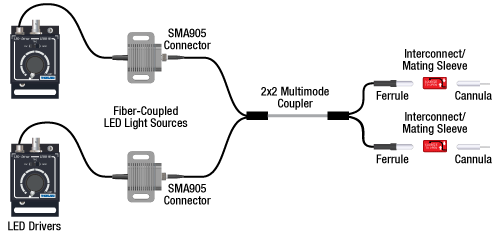
Option 3: One Light Sources to Seven Cannula Implants
If the intent is for one LED source to connect to seven cannulae for simultaneous light modulation, then a 1-to-7 fiber bundle can be used to split the light from the LED into each respective cannula. See the graphic and compatibility table below for the necessary cables and cannulae to create this setup. For LEDs and drivers, see below or the full web presentation.
Click on Each Component Below for More Information
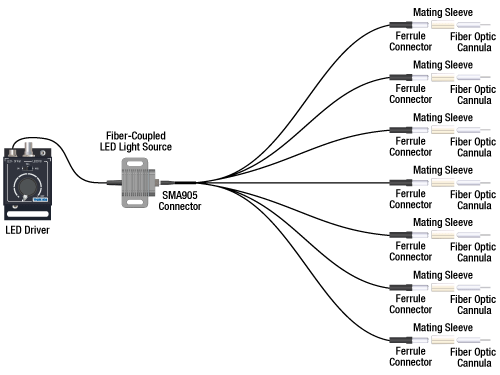
Two Light Sources into One Dual-Core Cannula Implant
For bilateral stimulation applications where the two cannulas need to be placed in close proximity (within ~1 mm), Thorlabs offers dual-core patch cables and cannulae that are designed for this specific application. Each core is driven by a separate light source, enabling users to stimulate and/or supress nerve cells in the same region of the specimen. See the graphic and compatibility table below for the necessary cables and cannulae to create this setup. For LEDs and drivers, see below or the full web presentation.
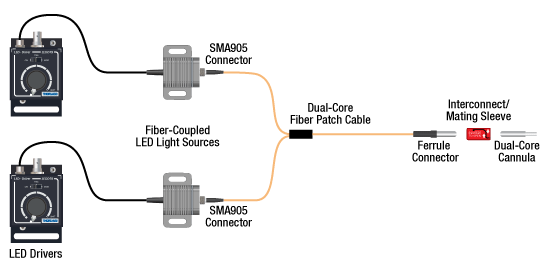
Click on Each Component for More Information
| Part Selection Table (Click Links for Item Description Popup) | |||||||||
|---|---|---|---|---|---|---|---|---|---|
| Common Fiber Properties | |||||||||
| Core Diameter | 200 µm | ||||||||
| Wavelength Range | 400 - 2200 nm | ||||||||
| NA | 0.39 | ||||||||
| Fiber Type | FT200EMT | ||||||||
| Ferrule Stylea | FC (Ø2.5 mm) | ||||||||
| Dual-Core Patch Cable | FC/PC Input | BFY32FL1 | |||||||
| SMA905 Input | BFY32SL1 | ||||||||
| Compatible Mating Sleeve/Interconnect | ADAF1 ADAF2 ADAF4-5 |
||||||||
| Dual-Core Fiber Optic Cannulaec | Stainless Steel | CFM32L10 CFM32L20 |
|||||||
| LED Item # | Wavelengtha | Typical Opsin | Output Powerb | Color |
|---|---|---|---|---|
| M385F1c | 385 nm | EBFP, moxBFP | 10.7 mW | UV |
| M405F1c | 405 nm | mmilCFP, hcriGFP | 3.7 mW | UV |
| M430F1 | 430 nm | ChR2 | 7.5 mW | Violet |
| M455F3 | 455 nm | ChIEF, bPAC | 24.5 mW | Royal Blue |
| M505F3 | 505 nm | ChRGR, Opto-α1AR, Opto-β2AR | 11.7 mW | Cyan |
| M530F2 | 530 nm | C1V1, VChR1 | 9.6 mW | Green |
| M565F3 | 565 nm | Arch, VChR1-SFO | 13.5 mW | Lime |
| M595F2 | 595 nm | ChR2-SFO, eNpHR3.0 | 11.5 mW | Amber |
| M625F2 | 625 nm | ReChR | 17.5 mW | Red |
Illumination
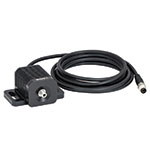
Click to Enlarge
M405F1
Fiber-Coupled LEDs and Drivers
Our fiber-coupled LEDs are ideal light sources for optogenetics applications. They feature a variety of wavelength choices and a convenient interconnection to optogenetics patch cables. Thorlabs offers fiber-coupled LEDs with nominal wavelengths ranging from 280 nm to 1050 nm. See the table to the right for the LEDs with the most popular wavelengths for optogenetics. A table of compatible LED drivers can be viewed by clicking below.

| Image | Ferrule Type | Fiber Type | Fiber Core Diameter |
Fiber Outer Diameter |
Core Spacing | NA | Wavelength Range | Compatible Patch Cables |
|---|---|---|---|---|---|---|---|---|
| Ø2.5 mm x 10 mm, Stainless | FT200EMT | 200 ± 5 µm | 225 ± 5 µm | 700 µm | 0.39 ± 0.02 | 400 - 2200 nm | BFY32 Dual-Core Patch Cables |

These dual-core patch cables are designed to be used with the dual-core cannula sold above. They are connected to cannulae using mating sleeves or the quick release interconnect.
| Item # | Fiber Type |
Wavelength Range |
Core Diameter |
Core Spacing |
NA | Cable Mass |
Ferrule Diameter |
Ferrule Material |
Connectors | Compatible Cannulae |
Operating Temperature |
|---|---|---|---|---|---|---|---|---|---|---|---|
| BFY32FL1 | FT200EMT |
400 - 2200 nm | 200 µm ± 5 µm | 700 µm | 0.39 | 118 g | 2.5 mm | Stainless Steel | Two FC/PC to Ferrule | CFM32 Dual-Core Cannulae | -50 to 60 °C |
| BFY32SL1 | Two SMA905 to Ferrule |
 Products Home
Products Home
















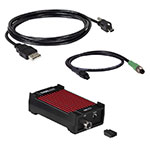
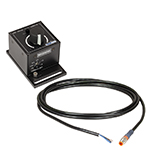
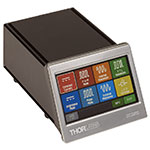
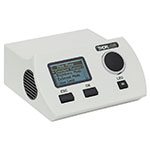
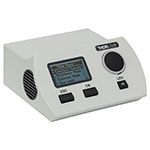

 Dual-Core Fiber Optic Cannula
Dual-Core Fiber Optic Cannula